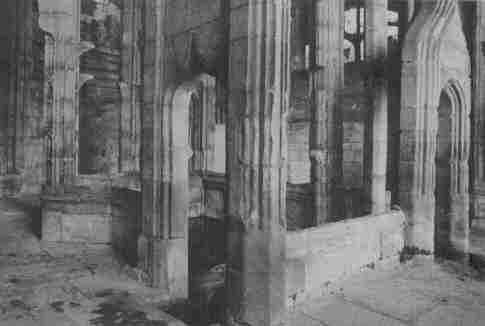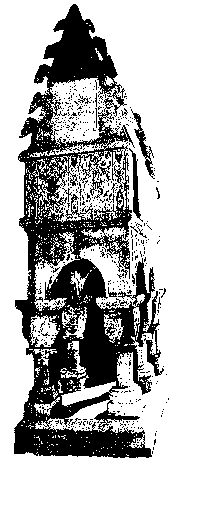
WALES
BRISTOL CHANNEL
FLAT HOLM
Cardiff's Port Isolation Hospital. Much of this infectious diseases hospital , built in 1896, has decayed away but what remains may one day be conserved as it is now a listed building. The island's principle claim to fame comes a year later from its connection with the history of radio ; the first wireless signal arrived here in May 1897, transmitted by Marconi.
The hospital was intended for the isolation of shipboard cases of cholera, yellow fever and plague. The first patients to be quarantined on the island had arrived a few years earlier and had to be accommodated in a tent. They were all suffering from cholera and one died. The last last patent to die in the hospital, a victim of bubonic plague was cremated here at the turn of the century. The hospital finally closed in 1935 and it has remained derelict ever since.
Access to the island is by boat from Barry Island and can be visited between April and October. The Flat Holm Project has its own boat "The Lewis Alexander" which takes about 30 minutes to cross from the Harbour at Barry. To find out more or to arrange a visit, contact The Flat Holm Project Office, Pier Head, Barry Docks, Barry. Tel: 01446 747661, e-mail: [email protected]
CLWYD
GLAMORGAN
CARDIFF.
St Fagans. The Welsh Folk Museum, part of the National Museum of Wales, lies to the west of Cardiff, between the A4119 and the A48. The Material Culture Gallery has a section on medicine and particularly an exhibit relating to Dr William Price, a pioneer of cremation. Price cremated the body of his 5 month old son in 1884 and was brought to trial at the Glamorgan Assizes. The case established the legality of cremation though it was not the first time a body had been cremated in Britain: in 1769 the body of Honoretta Pratt was burned in an open grave at St Georges Burial Ground ,Hanover Square, London, following her request. The first official cremation was carried out in Woking in March 1885 and it is now the preferred way of disposing the dead.
Pontypridd Common (OS reference ST 0797 9025) commands fine views over the town. Amongst the many glacial boulders, one boulder, known as the Rocking Stone, is the central point for the Druid's Circle of smaller stones which was constructed in the 19thC by Dr. William Price. Above the Common, towards Glyntaff, are the white washed Round Houses erected by Dr. Price who, with his colourful dress, long hair and cap of a whole fox's skin, was one of the most eccentric characters of Pontypridd.
St DAVID'S
.St Non's Chapel and Holy Well
. Non was the mother of St David. On a windswept cliff-top site, with marvellous views, are the ruins of a 14th century chapel and well (restored 1951) which is reputed to have power to heal eye afflictions. The well remains a place of pilgrimage.DYFED
Cardigan
St Dogmael's Abbey. Medaeval monastic infirmary ruins one mile west of the town on the B4546. All the walls of the infirmary except the north still stand almost to roof level. The recessed chamber at the west end of the south wall may have been the infirmary chapel.
GWENT
T
intern Abbey.The famous Cisterecian Abbey, founded in 1131, has extensive low wall remains of an elaborate infirmary complex, including hall, reredorter, kitchen and infirmary cloister. The hall (13th-14th centuries ; 107 x 54 feet) is divided into a nave with aisles, separated by rows of clustered columns. In the 15th century, the aisles were divided up into cubicles, each with its own fireplace. The infirmary cloister measures 84 x 71 feet.
Tredegar
Cefn Golau cholera cemetery lies in an isolated spot the the west of Tredegar. Here, beneath the few remaining gravestones lie the remains of over two hundred people who perished in the cholera epidemics of 1832, 1849 and 1866.
GWYNEDD
Bethesda
Penryn Quarry Hospital Opened in 1825, this slate quarry hospital is now only a ruin. It was here that one of the first operations to use ether anaesthesia was performed by Dr Hamilton Roberts. The operating table can still be viewed in the Exhibition Room of Penryn Castle.
Holywell.
 |
St Winefride's well.(left) Famous since the seventh century as a healing shrine, St Winefride's well is still a place of pilgrimage for people hopeful of a miraculous cure. The story goes that St Winefride was raped and murdered by a local miscreant and her uncle, St Beuno laid a curse upon the murderer and prayed that his neice might be restored to life. his prayers were answered when a spring gushed forth where St Winefride's garotted head had fallen. Margaret Beaufort, the mother of King Henry VII, erected a beautiful stone edifice over the well at the beginning of the sixteenth century. |
Trefriw Wells.
The chalybeate and sulphur waters were first discovered by the Romans but the bath house dates from 1743. Trefriw Wells closed in 1952 but reopened in 1977 and visitors are able to see ancient caves and purchase bottles of iron and sulphur water.
Llanberis
Opening times: Daily during main holiday periods,
11am-5pm (11am-4pm winter). Mainly open weekends only throughout the winter.
Phone 01286 870892first to check or arrange opening for group. Cost:
£1 adults, 50p children. Quarry Hospital, Llanberis, Gwynedd, LL55 4TY
Llangiby.
Ffynnon Gybi. A bath and beehive well house.
POWYS
Builth Wells.
A saline spring was said to have been discovered in 1830 by a party of mowers.
Llandegley.
Not much to see here nowadays except for an old wooden shack and a ditch smelling of sulphur. The spa closed in the 1930's
Llandrindod Wells.
Rock Park Spa
. The springs were known in the Roman era as the ''Balnea Siluria'' and in Victorian times as ''Fynnon cwm-y-gog'' which means the well in the cuckoo's valley. The present pump room was built around 1867 but fell into disuse and neglect during the 1970's. The Radnor District Council, aided by a grant from the Welsh Tourist Board restored the pump room in 1983 and the waters are once again available for tasting. There is a small exhibition about spas in mid-WalesLlanwrtyd.
Originally called the stinking spring, the water was first employed in 1732 by the Rev. Theophilous Evans who successfully cured his ''radicated scurvy'' after two months of bathing. The spring was subsequently diverted into a well and spa buildings and a hotel built.

Llangynog.
Pennant Melangell.
In an isolated valley a few miles north of Lake Vyrnwy in mid Wales lies the church of St Melangell, the patron saint of hares. Her relics are reputed to have healing properties and are contained in what is claimed to be the oldest Romanesque reliquary in northern Europe. In ancient times, diseased pilgrims lay under the reliquary's canopy in the hope of receiving a cure and people still come for the same purpose today. A book contains requests for help with conditions as diverse as multiple sclerosis, leukaemia and alcoholism. The church lies at the head of a small valley about two miles from Llangynog. Ancient yew trees in the graveyard are about 2000 years old. Long after the trees germinated, St Melangell came to the valley in 607 AD., founding a nunnery. She became associated with the cult of the hare, an animal revered for its beneficial influence on fertility.